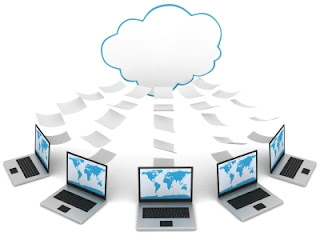What's Cloud Computing?
Have you heard about this term ?
Thus, the cloud itself becomes a service that we consume on our own needs. Such service may consist of hardware or software, or a combination of both, and is conceptually in the cloud. It is in this context that we will review later in a later article.
Another factor contributing to the concept of the cloud for its intangible essence is the fact that neither the user nor the developers know where or how your service is hosted (and certainly do not need to know). Perhaps not even the provider of cloud services to determine where you are immediately in an instance of the services within your data center.
The key features that should provide a service to be considered "Cloud Computing" are:
Self-service by customers
Ability to measure the service
Pay per use
Rapid elasticity
Geographical distribution
Within the cloud services there are three basic categories:1. - SaaS (Software as a Service): change is traditionally installed applications on their own infrastructure to the cloud versions. For example Exchange Online is a SaaS version of the mail server for Microsoft Exchange Server, which provides data centers hosted by Microsoft or its partners. A company can hire and start using it right away without having to purchase licenses or specific hardware, without having to maintain and paying only for what you use. Currently Microsoft offers a wide range of applications in SaaS mode through its Online Services.2. - IaaS (Infrastructure as a Service) is hosting existing applications within virtual machines in the cloud. Remain normal applications, running on a common operating system, only to run within virtual machines in the cloud. Lets worry about the management of physical servers, so that we avoid problems of hardware failure or local disasters, and usually offer the ability to grow in storage. However it is still necessary to address many other infrastructure issues such as high availability, load balancing, management and software based OS, etc ... Microsoft to manage this privately to companies through System Center and virtualization products. Examples of public best known of this type of service are Amazon EC2 and RackSpace.3. - PaaS (Platform as a Service): This is the cloud services for creating applications specifically developed for use in environments "Cloud" with the advantages already mentioned. All basic infrastructure, both software and hardware, are transparent to us. Application is created and deployed obtaining high availability, high scalability, and zero transaction costs. The disadvantage is that each platform has its own API PaaS development making it difficult to move an application from one to another "cloud". It is in this category where Windows Azure Platform fits. Other examples include Google App Engine or Salesforce's Force.com.Microsoft has a wide experience in providing cloud services, for at least 11 years, at both the end consumer and the business world. To get an idea about just a few figures:It houses more than 500 million Hotmail accounts / LiveMail in the worldManages over 620,000 Exchange accounts only in SpainSupports over 30,000 million with LiveID authentication monthThe MSN portal serves over 10,000 million pages per month.On average, every 30 days moving through the Messenger service over 240,000 million posts.They made 2,000 million searches a month in the search engine Bing.
How to implement this in my company Contact us @ david@glccorp.com or add us on Google +



Comments
Post a Comment